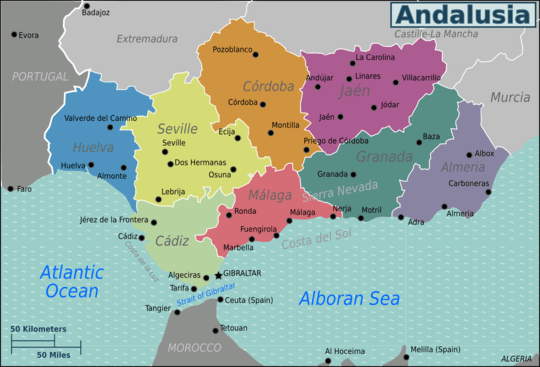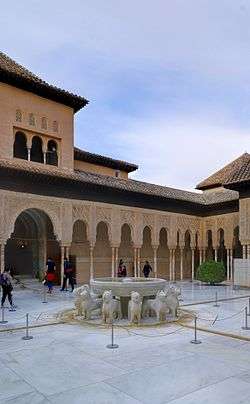Andalusia
Andalusia (Spanish: Andalucía) is the southern part of Spain. It has a heritage back to the Roman Empire, and a diverse scenery of deserts, beaches along the Costa del Sol and Costa de la Luz and the Sierra Nevada range, with Iberia's tallest mountains, and Europe's southernmost ski resorts.
- For other places with the same name, see Andalusia (disambiguation).
Andalusia encompasses an area of 87,268 km2 with 8.4 million inhabitants. To the south in the Province of Cadiz at the very tip of Spain lies the British overseas territory of Gibraltar where it is separate from North Africa by just a few miles.
Provinces
Andalusia is divided into eight provinces, each having the same name as its respective provincial capital city.

| Almería seen in dozens of movies |
| Cádiz |
| Córdoba |
| Granada |
| Huelva |
| Jaén |
| Málaga - includes Costa del Sol |
| Seville |
Cities
- 🌍 Seville — the heart of flamenco, the capital and largest city of Andalusia
- 🌍 Almería — lots of medieval remains and fortresses
- 🌍 Cádiz — the oldest continuously-inhabited city in the Iberian Peninsula and possibly of all of southwestern Europe
- 🌍 Córdoba — used to be the capital of an Islamic caliphate in the Middle Ages
- 🌍 Granada — home to the magnificent La Alhambra Palace
- 🌍 Huelva — a maritime port town with the oldest football club of Spain
- 🌍 Jaén — the world's capital of olive oil and a booming cultural tourism destination
- 🌍 Málaga — a large harbour city right on the Costa del Sol
- 🌍 Marbella — wealthy resort town on the Costa del Sol
Other destinations
- 🌍 Ronda — a beautiful town with an impressive bridge along the deep gorge
- 🌍 Úbeda and 🌍 Baeza — beautiful Renaissance monumental towns included into UNESCO's World Heritage List
- 🌍 Doñana National Park — UNESCO World Heritage site
- 🌍 Cabo de Gata-Níjar Natural Park
- 🌍 Alhama de Granada — an old spa village above a gorge
- 🌍 Baza National Park — 53,649 hectares of Natural Park
- 🌍 Costa del Sol — sunny beaches and beautiful villages along Spain's southern coast
- 🌍 Júzcar — a small village painted Smurf blue for 2011 movie Smurfs II.
- 🌍 La Alpujarra — a mountainous district south of the Sierra Nevada
- 🌍 La Axarchía — area north-east of Malaga, recently 'discovered'
- 🌍 Sierra Nevada — the highest mountains in the Iberian Peninsula, excelling for skiing and hiking
Understand

Andalusia has a rich Moorish heritage, including many fantastic examples of Moorish architecture which were built during the eight centuries when Andalusia was the centre of the Arab population in the Iberian peninsular. The Moorish rule effectively ended in 1492AD when the Christians recaptured Granada.
Nowadays, the region is a very popular tourist destination with a lot of British and German package holidayers coming to stay in the concrete resorts on the Costa del Sol. But if you stay away from the concrete resorts you will find lots of culture, amazing scenery and great food.
Talk
Like most of the rest of Spain, Andalusia's main language is Spanish, but with a local dialect. The local dialect is somewhat similar to the Spanish spoken in parts of Latin America such as Cuba and Colombia.
Get in
Major airports: Seville(Sevilla), Malaga, Almeria, Jerez de la Frontera.
By car
The main road routes into Andalusia are
By plane
Malaga has the third biggest international airport in Spain, which a lot of discount airlines fly to. From Malaga, the A-7 E-15 motorway runs westwards along the coast to Gibraltar and eastwards to Almeria and beyond. To head north from Malaga, the A-45 motorway runs to Cordoba. There are also airports in Sevilla, Jerez de la Frontera, Granada and Almeria
By train
Spain's railway network is not as developed as those of many other European countries, but Algeciras, Almeria, Cadiz, Granada, Huelva, Jaén, Malaga, Cordoba and Sevilla are all served by regular train services. Spain's highspeed AVE network connects Malaga, Cordoba and Sevilla to Madrid. Some of the other smaller towns are served by less frequent services, see individual city guides for further details. For more info, see the RENFE website.
See
- Moorish architecture in Granada, including the Alhambra.
- Lake Negratin is situated at the foothills of Mount Jabalcón. As one of Europes largest lakes, it really is worth seeing not least for the most magnificent lunar-landscape that surrounds it. The rock formations and the colours it produces during different times of the day can be likened to those of the Grand Canyon. There is a manmade beach where you can laze the day away, a number of restaurants dotted round the lake and on a nice day you can swim or take out a pedalo boat, which might lead you to pink flamingos and various other wildlife.
- Seron is nestled on the lower slopes of the Sierra de los Filabres and is a picturesque town that cascades down the hillside. Dominated by its Castle, which sits at the very top, Seron is famous for its ham and provides a more traditional experience of Andalusian life. It is a beautiful location to start your exploration of the Filabres, or visit at the right time of year and you might find yourself submerged in a vibrant fiesta.
- Las Menas, an old mining village abandoned thirty years ago, makes an interesting stop in the Sierra de los Filabres. You can investigate old ruins crumbling amidst the most breathtaking countryside, stop for coffee and cake at the hotel and even camp for the night.
Do
- Andaventur Granada Adventure Company. Outdoor sports in the Sierra Nevada National park and Granada province, Tandem paraglider flights, Canyoning, Hiking, Ski, Rock Climbing, Horse riding.
- Long clean beaches on the Costa del Sol and the Costa de la Luz.
- Walking and hiking in the Sierra Nevada
- Rock Climbing Company, ☎ +34 952 742 962, +44 1492 641430. High quality rock climbing and scrambling courses in Andalusia. Courses based in Malaga province both on the coast and also inland near to the El Chorro gorge.
- Windsurfing and Kiting in Tarifa Spains southern tip
- Horse riding and Spain go hand-in-hand and with such spectacular mountain ranges at your disposal as the Sierra Nevada and Alpujarra Hills; you have a feast of beautiful Andalusian trekking land to indulge in astride your faithful friend. There are several stables situated in these areas and all offer the option to ride for an hour, a day or even as long as 7 nights. Accommodation and food are included in prices and the whole experience offers a unique way to see this amazing part of Spain. Prices vary from 25 to 1200 EUROS and there are so many options to choose from that you will undoubtedly find something to suit your level and requirements.
- Flamenco is the all-Andlusian art with a history stretching back over 3,000 years. The Museo del Baile Flamenco (Flamenco Dance Museum) is the ideal place to learn more about this phenomenon. Shows are offered on Friday and Saturday nights at 19:30, too.
Events
- Andalusia day (Día de Andalucía): 28 February annually. Commemorates the February 28, 1980 referendum on the Statute of Autonomy of Andalusia, in which Andalusians achieved recognition for an autonomous region within the state of Spain.
Eat
Drink
Sleep
Stay safe
When in Granada, it is advisable to avoid women who are offering plants (usually heather). They will offer you a plant for free, and then when you accept it will read your palm and then demand money. If you refuse to give it to them, they may start screaming at you and it is a situation that you will generally want to avoid having to occur. Aside from this, the area is generally very safe, but one should still take the usual precautions, especially in Malaga, Seville, etc.